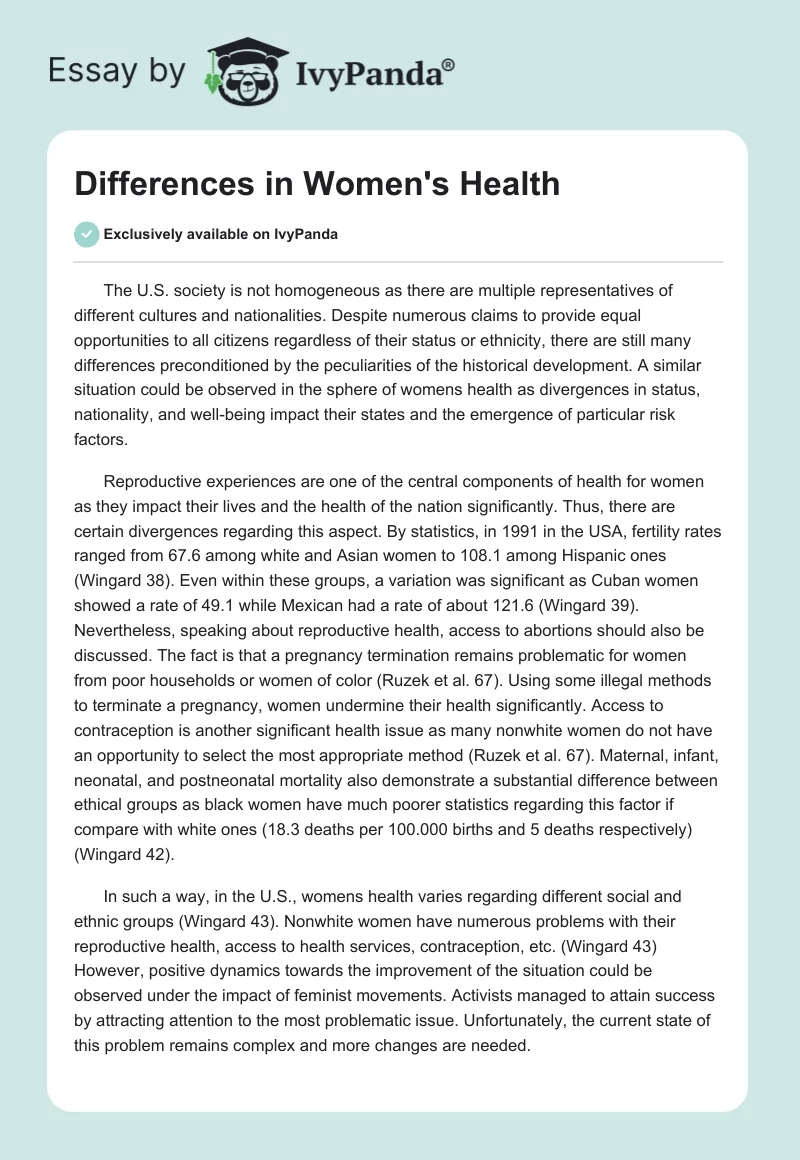The U.S. society is not homogeneous as there are multiple representatives of different cultures and nationalities. Despite numerous claims to provide equal opportunities to all citizens regardless of their status or ethnicity, there are still many differences preconditioned by the peculiarities of the historical development. A similar situation could be observed in the sphere of womens health as divergences in status, nationality, and well-being impact their states and the emergence of particular risk factors.
Reproductive experiences are one of the central components of health for women as they impact their lives and the health of the nation significantly. Thus, there are certain divergences regarding this aspect. By statistics, in 1991 in the USA, fertility rates ranged from 67.6 among white and Asian women to 108.1 among Hispanic ones (Wingard 38). Even within these groups, a variation was significant as Cuban women showed a rate of 49.1 while Mexican had a rate of about 121.6 (Wingard 39). Nevertheless, speaking about reproductive health, access to abortions should also be discussed. The fact is that a pregnancy termination remains problematic for women from poor households or women of color (Ruzek et al. 67). Using some illegal methods to terminate a pregnancy, women undermine their health significantly. Access to contraception is another significant health issue as many nonwhite women do not have an opportunity to select the most appropriate method (Ruzek et al. 67). Maternal, infant, neonatal, and postneonatal mortality also demonstrate a substantial difference between ethical groups as black women have much poorer statistics regarding this factor if compare with white ones (18.3 deaths per 100.000 births and 5 deaths respectively) (Wingard 42).
In such a way, in the U.S., womens health varies regarding different social and ethnic groups (Wingard 43). Nonwhite women have numerous problems with their reproductive health, access to health services, contraception, etc. (Wingard 43) However, positive dynamics towards the improvement of the situation could be observed under the impact of feminist movements. Activists managed to attain success by attracting attention to the most problematic issue. Unfortunately, the current state of this problem remains complex and more changes are needed.
Another problem threatening womens health is HIV. Specialists determine the current state as an epidemics threatening the health of the nation and resulting in the deterioration of the quality of life (CDC). For this reason, numerous attempts to investigate the problem to attain an improved understanding of its state and dynamics are made. At the same time, there are alterations in the ways the disease is treated and monitored. Thus, AIDS incidence achieved its peak in the early 1990s (CDC). At the given period, about 25.837 women were diagnosed with HIV (CDC). The number continued to grow as new and new cases were reported every year. However, in the 2000s the situation started to alter, and some improvement was observed. By the statistics, HIV diagnoses among women of all races living in the USA declined to 16% (Roser and Hannah). Additionally, the quality of their lives increased significantly (Roser and Hannah). These positive dynamics could be explained by the reconsideration of the approach to treatment. At the moment, new medicines to support the immune system and protect an individual from viruses are used (CDC). Moreover, education among the most vulnerable population groups and better access to contraception also contributed to the improvement of results regarding HIV and its further spread in the USA.
Works Cited
CDC.“HIV and AIDS — United States, 1981–2000.”cdc.gov, Web.
Roser, Max, and Hannah Rithie. “HIV/AIDS.”Our World in Data, Web.
Ruzek, Sheryl, et al. “What are the Dynamics of Differences?” Women’s Health: Complexities and Differences, edited by Sheryl Ruzek, Virginia Olsen, and Adele Clarke, Ohio State University Press, 1997, pp. 51-95.
Wingard, Deborah. “Patterns and Puzzles: The Distribution of Health and Illness among Women in the United States.” Women’s Health: Complexities and Differences, edited by Sheryl Ruzek, Virginia Olsen, and Adele Clarke, Ohio State University Press, 1997, pp. 29-45.


